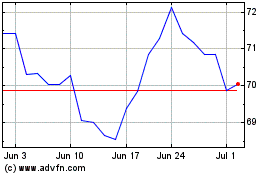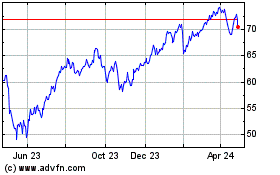As economic conditions begin to stabilize, plan sponsors of the
largest U.S. defined benefit (DB) pension plans are reprioritizing
the risks facing their plans by focusing on a smaller number of
risks and paying greater attention to them, according to the 2011
MetLife U.S. Pension Risk Behavior IndexSM (U.S. PRBI), released
today. Notably, two liability-related risks – Underfunding of
Liabilities and Asset & Liability Mismatch – are front and
center in importance in this year’s study. These findings are in
contrast to the 2010 U.S. PRBI study when plan sponsors placed
nearly equal importance on all risks facing their plan and the 2009
study, which found that plan sponsors were intently focused on the
asset side of the asset-liability equation.
The MetLife study, which surveyed 149 corporate plan sponsors
from among the 1,000 largest U.S. defined benefit (DB) pension
plans, measures plan sponsors’ aptitude for managing – and
attitudes about – 18 investment, liability and business risks to
which their plans are exposed.
“Plan sponsors are now placing a priority on liabilities in
overall pension plan risk management, focusing on a core set of
balanced risk factors,” said Robin Lenna, executive vice president
and head of MetLife’s Corporate Benefits Funding group.
Overall, the consistency between importance and success for each
of the 18 risk items has improved slightly in 2011 over 2010, even
though plan sponsors indicate they are not successfully managing
the two most important risks facing their plans.
Plan Sponsors Sharpen Their Focus on Liabilities
After the market uncertainty of the past two years that saw DB
pension plan assets decline and the value of liabilities rise, plan
sponsors are placing emphasis on two key liability-related risks:
Underfunding of Liabilities and Asset & Liability Mismatch. And
while Underfunding of Liabilities has always ranked high in
importance to plan sponsors, this year it was selected as the most
important more often than any other risk factor in the history of
the study. Specifically, when plan sponsors were asked to indicate
the importance of the 18 risk factors affecting their plan, these
top two risks were selected as the most important 66% of the time
and 60% of the time, respectively.
The third- and fourth-ranked risk factors this year, Asset
Allocation and Meeting Return Goals, are investment-related risks.
However, their selection rates are much lower than that of the top
two risk factors (45% and 41% of the time, respectively),
suggesting that plan sponsors are now focused on managing plan
assets in the context of plan liabilities.
By comparison, in 2009, these same four risk factors occupied
the top rankings, but then the investment-related risks (Asset
Allocation and Meeting Return Goals) were ranked first and second
in importance, while the liability-related risks (Underfunding of
Liabilities and Asset & Liability Mismatch) occupied the third
and fourth positions.
“With the top two risk factors on the liability side of the
asset-liability equation, followed by two asset-oriented factors,
we believe the asset-centric focus on investment returns that
characterized the inaugural study in 2009 have given way to one
that suggests that there is a growing interest on the part of plan
sponsors to manage plan assets in the context of plan liabilities,”
said Cynthia Mallett, vice president, Product & Market
Strategies, in MetLife’s Corporate Benefit Funding group, who
oversaw the study.
At the same time, Liability Measurement, the seventh most
important risk factor, was ranked first in terms of success.
“Having taken significant steps to better understand their
liability-related risks through formal liability measurement such
as actuarial valuations, asset-liability studies and other means,
many plan sponsors are now taking steps to mitigate them,” added
Mallett.
Plan Sponsors Take Deliberate Approach to Pension Risk
Prioritization
Plan sponsors’ more concentrated focus on several risks in 2011
highlights one of the shifts in pension risk management over the
past year. While, as noted earlier, the top two risks were selected
66% of the time and 60% of the time, respectively, the next two
most important risks were selected 45% and 41% of the time. This
contrasts with 2010, which was identified as a “democratization” of
risk, when the top two risks were selected only 28% and 27% of the
time, and the bottom two risks were each selected 21% of the time –
indicating that plan sponsors were reluctant to rule out the
potential significance of any of the risk factors.
“This year, we saw the range of Overall Importance Selection
Rates widen dramatically between the most and least frequently
cited across all 18 risk factors, from 8% in 2010 to 62% in 2011.
This indicates that plan sponsors are now starting to differentiate
among the risks facing their plans – and a core set of four risks
may be solidifying,” added Mallett.
Fluctuating Importance Ranking Indicates Some
Uncertainty
Despite plan sponsors’ concentration on four top risks facing
their plans, a significant amount of variability in importance
among the remaining risks over the past three years indicates some
uncertainty about which other risks should garner the most
attention. Several risk factors, including Meeting Return Goals,
Accounting Impact and Investment Management Style, dropped in the
importance ranking from 2009 to 2010, but have regained importance
in 2011. Conversely, Advisor Risk, Early Retirement Risk and
Inappropriate Trading rose in the importance ranking from 2009 to
2010, but fell in 2011.
“Volatility among risk factors indicates that there is a
floating group of risks that plan sponsors prioritize in the
short-term, but they fluctuate due to outside influences such as
economic, labor and market conditions, and legislative and
regulatory developments,” said Mallett.
Plan Sponsors Perceive Success in Managing Pension Risk, But
Gap Between Importance and Success Remains
Overall, plan sponsors continue to give themselves high marks
for successfully managing the risks facing their plans. In 2011,
plan sponsors reported that they were successful in managing their
risks 79% of the time, compared to 80% in 2010 and 75% in 2009.
But, the top two most important risk factors – Underfunding of
Liabilities and Asset & Liability Mismatch – ranked 11th and
13th in success, respectively, indicating that plan sponsors are
not managing the most important risks successfully.
With funded status continuing to present challenges, plan
sponsors remain concerned about their ability to successfully
manage the impact of underfunded plans. Similarly, the disconnect
between importance and success for Asset & Liability Mismatch
may be due to the fact that pension plans underwent significant
turmoil over the past two years, with lower asset valuations as a
result of market fluctuations, and a rise in liabilities due to a
low interest rate environment.
U.S. Pension Risk Behavior IndexSM Value: A
Slight Improvement from 2010
The third annual value of the U.S. PRBI is 81 out of 100, a
slight improvement from 79 in 2010 and slightly down from 82 in
2009. The Index calibrates the importance that plan sponsors surveyed ascribed to
each risk, their reported success at
implementing comprehensive practices to manage each risk and the
consistency between the two,
effectively measure both attitudes toward, and aptitude for,
managing pension plan risks.
“This study has become instrumental in tracking how pension risk
factors are being balanced, and how well they are being managed,”
said Mallett. “Over the next several years, we expect that plan
sponsors will deepen their focus on a core set of risks facing
their plans, and implement strategies to more successfully manage
them.”
About the Study
The MetLife U.S. Pension Risk Behavior IndexSM was conducted in
conjunction with two research partners – Bdellium Inc. and
Greenwich Associates – during the period of August through December
2010. Commissioned by MetLife, the U.S. PRBI surveyed 149 large
plan sponsors (94 of which reported defined benefit assets of more
than $1 billion). Interviews were completed by telephone with a
web-assisted option, i.e., respondents had the ability to view the
risk factors and questions online while answering the survey via
telephone. Respondents consisted of senior financial professionals
whose primary focus is pension investments, risk management or
employee benefits, in addition to corporate management. A complete
report of the findings for the MetLife U.S. PRBI (and detailed
description of the research methodology) is available at
www.metlife.com/pensionrisk.
About MetLife
MetLife, Inc. is a leading global provider of insurance,
annuities and employee benefit programs, serving 90 million
customers in over 60 countries. Through its subsidiaries and
affiliates, MetLife holds leading market positions in the United
States, Japan, Latin America, Asia Pacific, Europe and the Middle
East. For more information, visit www.metlife.com.
MetLife (NYSE:MET)
Historical Stock Chart
From Sep 2024 to Oct 2024

MetLife (NYSE:MET)
Historical Stock Chart
From Oct 2023 to Oct 2024
